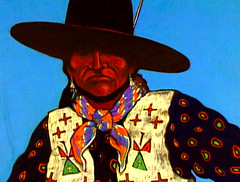"The Caddo Nation is a confederacy of several Southeastern Native American tribes," says Wikipedia, "who traditionally inhabited much of what is now East Texas, northern Louisiana and portions of southern Arkansas and Oklahoma. Today the Caddo Nation of Oklahoma is a cohesive tribe with its capital at Binger, Oklahoma.
The Caddo lived in the Piney Woods eco-region of the United States up to the foothills of the Ozark Mountains and often near the Caddo River.
Several Caddo villages were resettled, including the community of Elysian Fields, Texas, and Nacogdoches and Natchitoches, both of which have kept their original names. The Caddo were progressively moved further west until they reached what is now western Oklahoma.
Caddo food varied in many types, the most common being dried corn. Sunflower seeds and pumpkins were also important staples with cultural significance, as were wild turkeys.
The Caddo first encountered Europeans in 1541 when the Hernando de Soto Expedition came through their lands.[16] De Soto's force had a violent clash with one band of Caddo Indians, the Tula, near Caddo Gap, Arkansas.
The Caddo tribes were divided into three confederacies when first encountered by the Europeans, the Hasinai, Kadohadacho, and Natchitoches, and loosely affiliated with other tribes. The Haisinai lived in East Texas, the Kadohadacho lived near the border of Texas, Oklahoma, and Arkansas, and the Natchitoches lived in now northern Louisiana.[17]
With the arrival of missionaries from Spain and France a smallpox epidemic broke out that decimated the population. Measles, influenza, and malaria also devastated the Caddo, as they were Eurasian diseases to which they had no immunity.[14]
Before extensive European contact, some of the Caddo territory was invaded by migrating Osage, Ponca, Omaha and Kaw, who had moved west beginning about 1200 CE because of years of warfare with the Iroquois in the Ohio River area of present-day Kentucky. The Osage particularly dominated the Caddo and pushed them out of some former territory, becoming dominant in the region of Missouri, Arkansas, Kansas and Oklahoma.
Having given way over years before the power of the former Ohio Valley tribes, Caddos later negotiated for peace with Spanish, French, and finally Anglo-American settlers. After the 1803 Louisiana Purchase, the United States government sought to ally with the Caddos. In 1835 the Kadohadacho, the northernmost Caddo confederacy, signed a treaty with the US to relocate to then Mexico. This area had been rapidly transformed by greatly increased immigration of European Americans, who in 1836 declared independence from Mexico with the Republic of Texas.[14]
"Texas" comes from the Hasinai word táysha, meaning "friend."[18]"
Please answer the reading comprehension quiz which follows on the blog; the questions are taken directly from this article.
skip to main |
skip to sidebar
For students and parents who love education and exploration of the social sciences . . .
Search This Blog
Followers
Blog Archive
-
▼
2010
(346)
-
▼
August
(27)
- Quiz on the background of the Caddo peoples
- Project on the Five Themes of Geography as they ap...
- In-class project: Atlantic storm tracking map
- Basics of geography: the projections used in const...
- Open notes, multiple choice quiz on Th/Fr: identif...
- Mississippi valley map quiz Tues/Wed: 15 pts on me...
- Holistic teaching: kinesiology, oxygenation and st...
- Fifth anniversary of the flooding of New Orleans a...
- Spaceship earth: teaching and using the system of ...
- Indigenous peoples: the original inhabitants
- What does a Hydrologist do?
- Fruit or nuts as a school day snack, rather than c...
- Mimal & Wiktm and mnemonics
- Spaceship Earth teaching project
- Notes on population, Ramadan and coordinates
- The implications of 6.8 billion people
- Enrichment reading: the history of navigation
- Multiple choice, open notes test: first quiz in ge...
- World geography project: latitude & longitude revi...
- World Geography additional text: The 2009 World Al...
- What's for lunch this week: Pimento Cheese sandwich
- Out of print: the long-valued Rand McNally Quick R...
- "Caddo:" what's the background of the name of this...
- Looking historically at the name "Caddo" - a diagn...
- Class of 2014 Talent Show performance night schedu...
- Water Bottle represents an industry that is far fr...
- US no longer leads in college degrees, ages 25 to ...
-
▼
August
(27)

